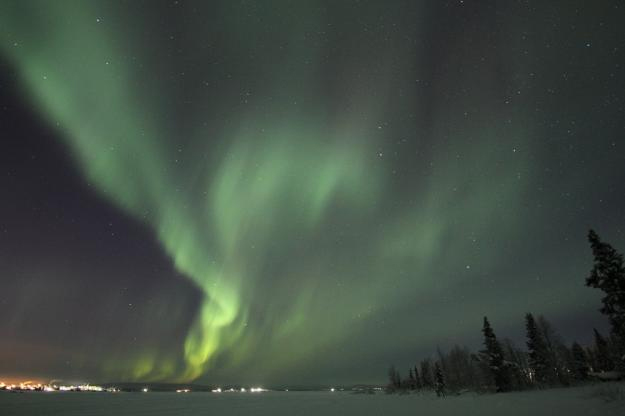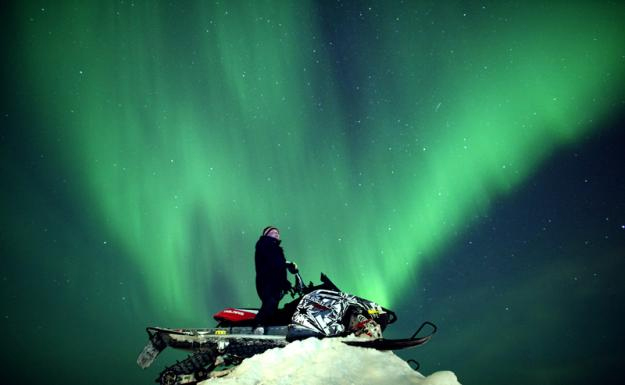Spectacular Northern Lights From Solar Storm Wow Skywatchers

A dazzling display of auroras lit up the far northern skies Tuesday night (Jan. 24) in a supercharged light show captured on camera by skywatchers around the world.
"I was screaming from excitement like a small kid at Christmas," said skywatcher Jens Buchmann, who watched the northern lights dance across the sky from Kiruna, Sweden.
The northern lights show was sparked by an intense solar flare that erupted from the sun late Sunday (Jan. 22). The flare unleashed a wave of charged particles, triggering the strongest solar radiation storm since 2005, NASA scientists said, adding that some minor satellite interference was possible.
Buchmann and a friend booked a last-minute flight from Stockholm to Kiruna after hearing about the solar storm. They braved freezing temperatures of about minus 22 degrees Fahrenheit (minus 30 degrees Celsius) in order to see the aurora display, moving inside only to thaw off before heading out again. Their photos show wispy green ribbons of energy rippling across the sky over a snow-covered landscape. [See video and photos of the solar storm's northern lights]
"After the main show was over I just continued lying in the snow for nearly two hours and watched the fainter, but fast-pulsating auroras that were everywhere," Buchmann told SPACE.com in an email. "All faint stars just lost their meaning behind these auroras."
The auroras from the solar flare could potentially be seen at latitudes as low as Maine or Montana, they added.
"The trip was totally worth it!" Buchmann said.
Breaking space news, the latest updates on rocket launches, skywatching events and more!
Delta Airlines officials said the commercial airline rerouted some planes from polar routes as a precaution to avoid any interference from the solar storm, according to press reports.
Buchmann and his friend were not the only skywatchers to make a special trip to see the auroras.
In Muonio, Lapland in Finland, skywatcher and photographer Antii Pietkänen made a special snowmobile ride with companion Thomas to try to catch the display. They posted one photo to the skywatching website Spaceweather.com, which received several others from different observers.
"The show started slowly and after 15 [minutes] the landscape was green!" Pietkänen told Spaceweather.com. "This was the first time for Thomas to see the northern lights, and he was very happy."
Photographer Chad Blakely in Lapland, Sweden recorded an eye-popping time-lapse video of the northern lights display, showing auroras swirling over a snowy meadow while observers alternate between snapping photos and staying warm at a campfire.
A streaming camera at the Aurora Sky Station in Sweden's Abisko National Park, an observing post for aurora hunters, beamed real-time photos of the northern light show every few minutes. The images revealed stunning hues of red and green across the northern night sky.
Auroras are created when charged particles from the sun interact with Earth's upper atmosphere, causing an energy release that can be seen as lights. Because the charged solar particles are typically funneled to Earth's poles by the planet's magnetic field, the most dazzling displays occur in the far north and south. The so-called northern lights are known as the aurora borealis, while their southern counterpart is dubbed the aurora australis.
Tuesday's aurora display was sparked by a powerful solar flare on Sunday night that triggered an eruption of solar plasma, called a coronal mass ejection. The flare was classified as an M9-class solar flare, a moderate — but still powerful — sun storm. This eruption flung charged particles out into space, which delivered a glancing blow to Earth.
The sun storm is only the latest solar weather to ignite dazzling auroras on Earth. A series of flares late last week made for a great weekend northern lights show for some observers, even as the sun was unleashing its latest solar tempest.
The sun is currently in an active phase of its 11-year solar cycle, which is called Solar Cycle 24. Solar activity is expected to peak in 2013.
You can follow Tariq Malik on Twitter @tariqjmalik. Follow SPACE.com for the latest in space science and exploration news on Twitter @Spacedotcom and on Facebook.

Tariq is the award-winning Editor-in-Chief of Space.com and joined the team in 2001. He covers human spaceflight, as well as skywatching and entertainment. He became Space.com's Editor-in-Chief in 2019. Before joining Space.com, Tariq was a staff reporter for The Los Angeles Times covering education and city beats in La Habra, Fullerton and Huntington Beach. He's a recipient of the 2022 Harry Kolcum Award for excellence in space reporting and the 2025 Space Pioneer Award from the National Space Society. He is an Eagle Scout and Space Camp alum with journalism degrees from the USC and NYU. You can find Tariq at Space.com and as the co-host to the This Week In Space podcast on the TWiT network. To see his latest project, you can follow Tariq on Twitter @tariqjmalik.


